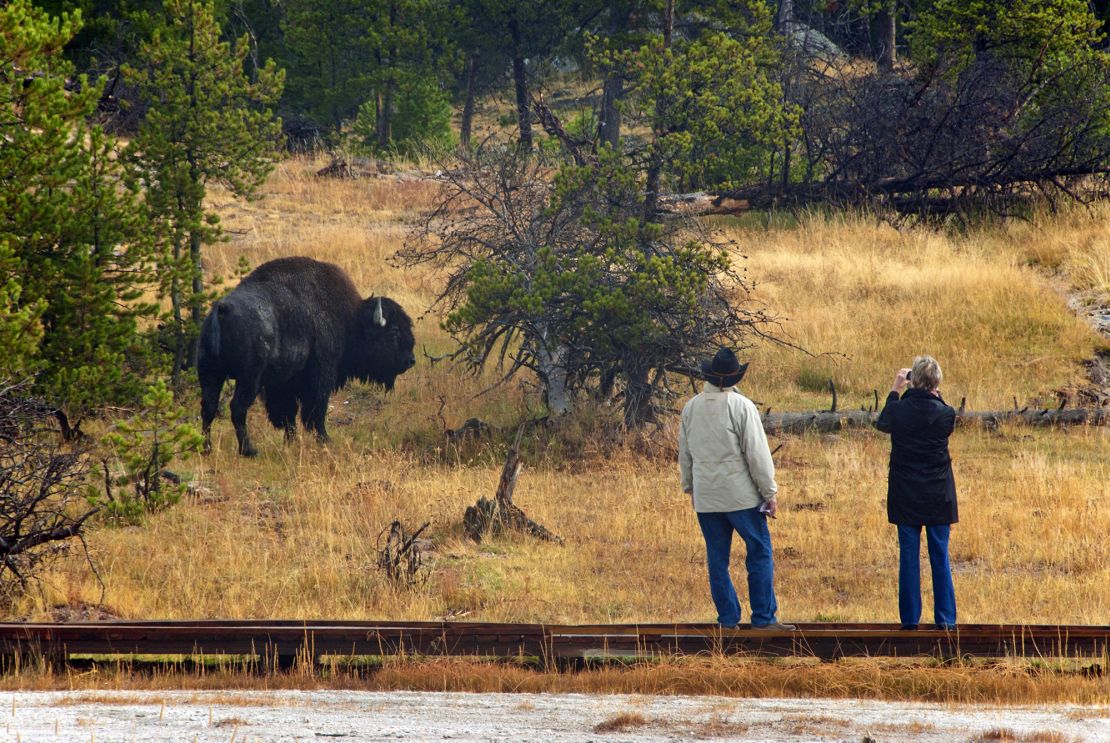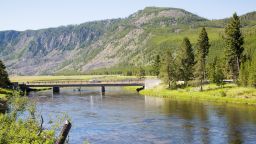Editor’s Note: “Close Encounters: Tourists in the Wild” on The Whole Story with Anderson Cooper takes us to Yellowstone National Park, where visitors behaving badly can lead to dangerous encounters with bears, bison and more. It premieres Sunday, August 25, at 8 p.m. ET/PT on CNN.
A dangerous encounter with a territorial bison and the subsequent viral video were not what Rebecca Clark had in mind when she set out for Caprock Canyons State Park in early October 2022.
She had been so enamored with Texas’ third-largest state park on her first solo hiking and camping trip there a year earlier that she decided to go back for more. Roughly two hours by car from either Lubbock or the Panhandle city of Amarillo, Caprock attracts visitors with big blue skies, brown and green prairielands and rugged red-rock formations.
Caprock has another draw – its wild bison herd, about 350 strong in late 2022. But bison, the great symbolic animal of the Great Plains, weren’t on her radar. Until suddenly, they were.
The Texas resident recounted her experience with CNN’s Ed Lavandera, telling him that she came upon a herd while she was walking a trail back from Lake Theo.
“I decided to just kind of wait for them to … ?get across the trail, and then I would pass them.” But they weren’t moving away fast enough for Clark. She said she decided to just walk by them – closer than the recommended safety distance. She was recording the moment on her smartphone.
In her video, Clark can be heard saying, “Thank you, I appreciate it” as she passes the animals.
Things got dangerous very quickly when one of the agitated bison took notice. “When I saw him turn, it’s like instantly I knew he was gonna come after me.”
And that’s exactly what the bison did. Once it charged, the large mammal was upon Clark within two seconds despite her frantic attempt to flee.
“It was so fast. He hit me in the back, rammed me, hooked me, then flipped me up and face forward into the mesquite bush.”
And there was Clark. Gored, bleeding and alone. How would she survive?
‘People can get hurt’
If provoked, it’s small wonder bison can prove so dangerous to unarmed people such as Clark. An adult male can weigh from 2,000 to 2,200 pounds (907 to 998 kilograms) and an adult female can weigh 1,000 pounds (454 kilograms), according to the National Park Service.
Add in their sharp horns and surprising speed (at least 30 mph or 50 kmh), and you’re dealing with a formidable animal. Wolfpacks and grizzly bears are the only large natural predators of adult bison.

But then there are humans, and it’s no contest when it’s armed hunters vs. bison herds. Native Americans lived in balance with bison for centuries, but contact with waves of European settlers proved cataclysmic for the animals. When they were on the brink of extinction in the late 1800s, conservationists stepped in.
Today, herds roam in parts of 12 US states. (Click here for all NPS sites that have bison). Yellowstone National Park is the only place where they have grazed continuously since prehistoric times.
With wilderness areas so popular, it gets complicated trying to manage visitor-wildlife interaction. That’s where people such as Chris Geremia, senior bison biologist at Yellowstone, come in.
“That first moment you see a grizzly bear, you see a wolf, you see a bison in this park – you will never forget that. And we need people to be able to have those moments. That’s partly what makes this place so special,” Geremia told CNN’s Lavandera.
“But it also means people can get hurt. You have to try and communicate to folks. You got to stay back. You have to give wildlife space because they are wild animals.”
But how can things so wrong between placidly grazing, plant-eating bison and folks who just want to get a good look at them?
“They’re a very peaceful animal, [but] if pushed, bison will become incredibly aggressive, they’ll defend themselves,” Geremia said.
How to avoid a bison attack

Keeping a respectful distance as you view these creatures is your best strategy to avoid attack. But how close is too close? Expert guidance varies.
NPS suggests maintaining “a distance of 100 feet (30 meters or two bus lengths) from bison.” The Catalina Conservancy recommends people stay at least 125 feet (40 yards or 38 meters) away from bison, though it notes there’s no firmly guaranteed safe distance. Parks Canada suggests an even longer distance. “Do not approach a bison closer than 100 metres (about 330 feet) and never try to chase or scare bison away.”
Be sure to get local guidance before you head out into parks. Also, NPS suggests bringing a camera with a telephoto lens to snap photos from more than 25 yards away. That lens can help you avoid the temptation to inch closer and closer.
Raised tails and other signs of agitation

You don’t need to be an expert in bison to sense something is amiss.
“The animals will let you know when you’re too close,” Geremia said. “They will raise their tail straight up. It will bob or shake their head. It will paw the ground. And that means you’re … way too close.”
Just being noticed is enough to put you on high alert, according to the Utah Division of Wildlife Resources. “If you see a bison and it stops what it is doing and starts paying attention to you, you are too close and should slowly back away.”
Other signals of potential trouble from bison:
? It keeps staring at you.
? It sways its head from side-to-side and bellows or huffs.
? It turns its back to you, raises its tail and defecates.
? It makes a “bluff charge,” in which the animal starts a run but stops short before making contact.
And what should you do if you see these signs?
“You need to back up. So I would literally just walk away,” Geremia said. “The faster you walk away, the better. That’s all that animal’s asking you to do.”

Special times to stay extra cautious:
? May and June (when cows are very protective of calves).
? July and August (that’s mating season, called “the rut,” when bulls are aggressive.
? When cycling (you can come up too quickly and quietly upon herds).
? When you’re with dogs (keep them on a leash).
Catalina Conservancy advises to make noise when hiking to avoid startling bison and don’t wear earbuds so you can also hear possible wildlife nearby.
If hiking, don’t be too trail-committed, the Utah DWR says.
“If you are hiking and a bison is close to or on the trail, you should either back away and return the way you came, or leave the trail and give the animal a very wide berth when passing it.”
The worst-case scenario is actually being charged, as Rebecca Clark was in Texas. If that happens, Catalina Conservancy suggests:
? Act assertively, yell loudly and wave your arms.
? If possible, throw something that may break the bison’s gaze.
? If you cannot avoid contact, get as low to the ground as possible and protect your head and torso.
? Playing dead may stop an attack.
But if you’ve got a 2,000-pound animal with horns coming at you at 30 mph, “You’re going to be severely hurt,” Geremia said.
‘I thought I was paralyzed’
Rebecca Clark knew for sure she was hurt.
“I knew he had hit me. I didn’t know he had gored me. … To tell you the truth, I thought I was paralyzed. It numbed me that much,” she said. “I flipped myself over, and I knew I needed to call for help. That was my first instinct.”
Thankfully for Clark, she was conscious and able to move. She started sending texts to her son and two friends for help. At one point, she thought she felt her water bottle leaking. But that was blood she felt from being gored.
The bison herd remained in Clark’s general vicinity, she said, until a park ranger came to the rescue about 40 minutes later, she estimated. About 10 minutes after that, medical emergency personnel arrived.
She was hospitalized for six days and received intensive wound care so that the three-inch gash in her back wouldn’t get infected. Clark said she decided to share her video on social media so others could learn from her incident.
“You know, I wasn’t as diligent as I should have been about knowing about bison before I went hiking.”
But she doesn’t want anyone to be scared off from outdoor excursions in the wild after what happened to her.
“I’m trying to protect the opportunity to go experience nature.”

![Site[13][65].jpg](https://media.cnn.com/api/v1/images/stellar/prod/site-13-65.jpg?c=16x9&q=h_144,w_256,c_fill)

